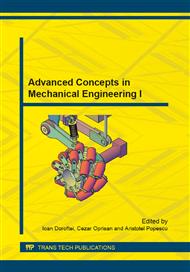p.447
p.453
p.459
p.465
p.471
p.477
p.483
p.489
p.495
Modeling and Design of Prosthetic Abutment System to Evaluate the Complex Interface
Abstract:
The biomechanics of the stump-prosthesis system and of the biphasic interaction between bone and muscle and also between stump and prosthesis belongs to a new interdisciplinary field in which modeling and numerical simulation research is the best solution to capture and investigate particular biomechanical aspects that have a high degree of intra-and inter-individual variability. By means of the reverse dynamics method, during the foot resting on the floor stages, one may thus define the biomechanical models of the anatomic stump-prosthesis system. The solution suggested relies on a set of methods including techniques specific to medical imaging analysis and processing, graphical 3D representation of the anatomic model developed using experimental data and its manipulation for study-related purposes or for later processing.The CAD modeling of the anatomic structures and prosthesis components was done using a series of conventional techniques available in the CAD SolidWorks 2008 and CosmosWorks2008 programming environment. A prerequisite for a successful recovery process is the patient’s availability to get actively involved in a physical therapy program. The monitoring of patients with amputated limbs that leave the hospital and of the complications developed in time in these patients is difficult since some miss their periodic follow-up examinations or are referred to other specialized departments. Therefore, a prediction of the evolution of the diminished functional capacity of patients with amputated limbs by stump-prosthesis system design using the finite element method is much more efficient.
Info:
Periodical:
Pages:
471-476
Citation:
Online since:
October 2014
Authors:
Keywords:
Price:
Сopyright:
© 2014 Trans Tech Publications Ltd. All Rights Reserved
Share:
Citation:


